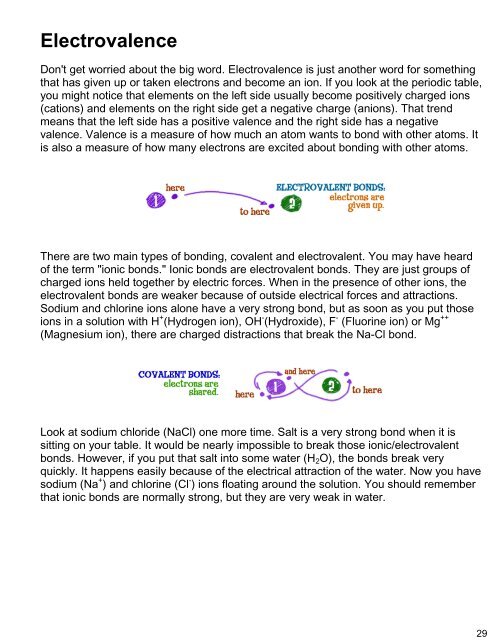Create successful ePaper yourself
Turn your PDF publications into a flip-book with our unique Google optimized e-Paper software.
Electrovalence<br />
Don't get worried about the big word. Electrovalence is just another word for something<br />
that has given up or taken electrons and become an ion. If you look at the periodic table,<br />
you might notice that elements on the left side usually become positively charged ions<br />
(cations) and elements on the right side get a negative charge (anions). That trend<br />
means that the left side has a positive valence and the right side has a negative<br />
valence. Valence is a measure of how much an atom wants to bond with other atoms. It<br />
is also a measure of how many electrons are excited about bonding with other atoms.<br />
There are two main types of bonding, covalent and electrovalent. You may have heard<br />
of the term "ionic bonds." Ionic bonds are electrovalent bonds. They are just groups of<br />
charged ions held together by electric forces. When in the presence of other ions, the<br />
electrovalent bonds are weaker because of outside electrical forces and attractions.<br />
Sodium and chlorine ions alone have a very strong bond, but as soon as you put those<br />
ions in a solution with H + (Hydrogen ion), OH - (Hydroxide), F - (Fluorine ion) or Mg ++<br />
(Magnesium ion), there are charged distractions that break the Na-Cl bond.<br />
Look at sodium chloride (NaCl) one more time. Salt is a very strong bond when it is<br />
sitting on your table. It would be nearly impossible to break those ionic/electrovalent<br />
bonds. However, if you put that salt into some water (H 2 O), the bonds break very<br />
quickly. It happens easily because of the electrical attraction of the water. Now you have<br />
sodium (Na + ) and chlorine (Cl - ) ions floating around the solution. You should remember<br />
that ionic bonds are normally strong, but they are very weak in water.




